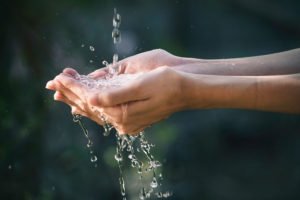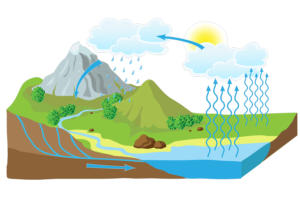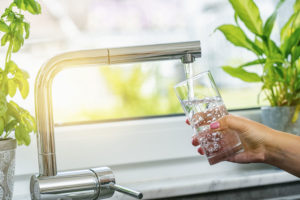Use Water Wisely
Why Save Water?
Water is essential to life on earth. We need water to grow food, keep clean, provide power, control fire, and last but not least, we need it to stay alive!

If water is constantly being cleaned and recycled through the earth’s water cycle, why do we need to conserve it? The answer is that people use up our planet’s fresh water faster than it can naturally be replenished.
To provide enough clean fresh water for people, water is cleaned at drinking water treatment plants before it is used. And after water is used, it is cleaned again at wastewater treatment plants or by a septic system before being put back into the environment.
Saving water is good for the earth, your family, and your community:
- When you use water wisely, you help the environment. You save water for fish and animals. You help preserve drinking water supplies, and you ease the burden on wastewater treatment plants. The less water you send down the drain, the less work these plants have to do to make water clean again.
- When you use water wisely, you save energy. You save the energy that your water supplier uses to treat and move water to you and the energy your family uses to heat your water.
- When you use water wisely, you save money. Your family pays for the water you use. If you use less water, you’ll have more money left to spend on other things.
The Water Cycle

Nature is always moving water through the air and land, so that the water we use is constantly recycled. The water cycle includes these steps:
Evaporation—The sun heats water in rivers, lakes, and the ocean and turns it into vapor or steam, which then rises into the air.
Condensation—The vapor cools and turns into tiny water droplets that attach to each other and form clouds.
Precipitation—Water falls from the clouds as rain, snow, sleet, or hail.
Runoff—Some water stays on the earth’s surface and flows into rivers, lakes, reservoirs, etc.
Percolation—Other water seeps down into the earth’s natural underground reservoirs, called aquifers. Then the cycle begins again, as water from the earth’s surface evaporates into the air.
Where Your Water Goes
The average person uses approximately 62 gallons of water per day. That’s more than enough to fill two big bathtubs! (You use less if your home has water-saving showerheads, faucets, toilets, and a water-saving washing machine.)

On a typical day, here’s where your 62 gallons goes:
- 21 gallons (34%) is used for baths and showers.
- 18 gallons (29%) is used to flush the toilet.
- 12 gallons (19%) is used for laundry.
- 8 gallons (13%) is used in the kitchen.
- 3 gallons (5%) is used outdoors.
Some water isn’t put to use at all! The average family loses approximately 14% of their water usage through leaks. A water faucet that leaks one drip per second will waste about 2,400 gallons per year, while a toilet that runs after flushing can waste up to 53,000 gallons of water in a year.
After water leaves your home, it is treated at a wastewater treatment plant or by your septic system. The water is cleaned and then released into the environment.
How YOU Can Save Water
Here are some ways you can use water more efficiently. Share these tips with your family.
- Brush Teeth Wisely
Turn off the water while you brush your teeth, and save 4 gallons a minute. That’s 200 gallons a week for a family of four. - Don’t Waste Drinking Water
Keep a pitcher of water in the fridge instead of running the tap until the water becomes cold. - Use Less Water for Dishes
Scrape your dishes clean to reduce rinsing. Run the dishwasher only when it’s full. If you wash by hand, use basins rather than running water. - Wash Hands Efficiently
Turn off the water while you soap your hands, and rinse briefly. - Flush Only When Necessary
Put paper, insects, hair, and other such waste into the garbage can rather than in the toilet. Every time you avoid flushing the toilet it saves many gallons of water. - Stop Leaks
Turn off water faucets tightly so they don’t drip. If you find a water fountain at school that won’t turn off, a leaky faucet, or a toilet that keeps running, tell the custodian. If you find a drippy faucet at home, tell an adult. - Wash Clothes Wisely
Make sure your clothes are truly dirty before putting them into the hamper. Wash clothes only when you have a full load, and use cold water whenever possible. Washing in cold works just as well as using hot or warm—and it uses less energy. - Don’t Overwater
Remind adults to water the lawn only once a week for no more than an hour—less if it rains; to water lawns in the early morning or late evening to limit evaporation; and to keep grass about 2 1/2 inches high. Taller grass shades the roots and holds moisture better. - Sweep to Save
Use a broom, rather than a hose, to clean off sidewalks and driveways. - Wash Cars Wisely
Wash your car at a car wash so the soapy water can be properly recycled. If you do it yourself, use a shutoff nozzle on your hose to limit water waste when soaping your car. You can save over 100 gallons this way. - Collect Unused Water
Place a bucket in an unused shower or sink to collect the water while you’re waiting for it to heat up. The collected water can then be used for plants and clean-up jobs. - Install Water-Saving Fixtures
Water-efficient showerheads, faucets, and toilets can save hundreds of gallons per year.
Activities
Try some of these activities around your house to see if you and your family are using water wisely.
Fix Your Faucets
![]()
A leaky faucet can waste about 200 gallons of water per month. Check the faucets in your kitchen, bathroom, laundry room, and outdoors by turning them on briefly, then off. Do you see any leaks? If so, ask an adult to fix them. Tell your teacher or the custodian about any leaky faucets at your school.
Check Your Toilet
![]()
A leaky toilet can waste as much as 200 gallons of water per day. Ask an adult to help you check your toilets for leaks. Lift the top lid and add a few drops of blue food coloring to the tank. Then wait a few minutes. Does color appear in the toilet bowl? If so, water is leaking from the tank into the bowl. The flapper valve in the tank may need to be replaced.
Test Your Shower
![]()
It takes energy to heat water, so if you can use hot water more efficiently you can conserve water and energy at the same time. To find out if your shower is using more water than necessary, open an empty half gallon cardboard milk carton and hold it up to your showerhead while it is fully on. Be sure to catch all the water that comes out. If the carton fills in less than 10 seconds, your shower could use an energy-efficient showerhead. This could save your family more than 1,700 gallons per month!
